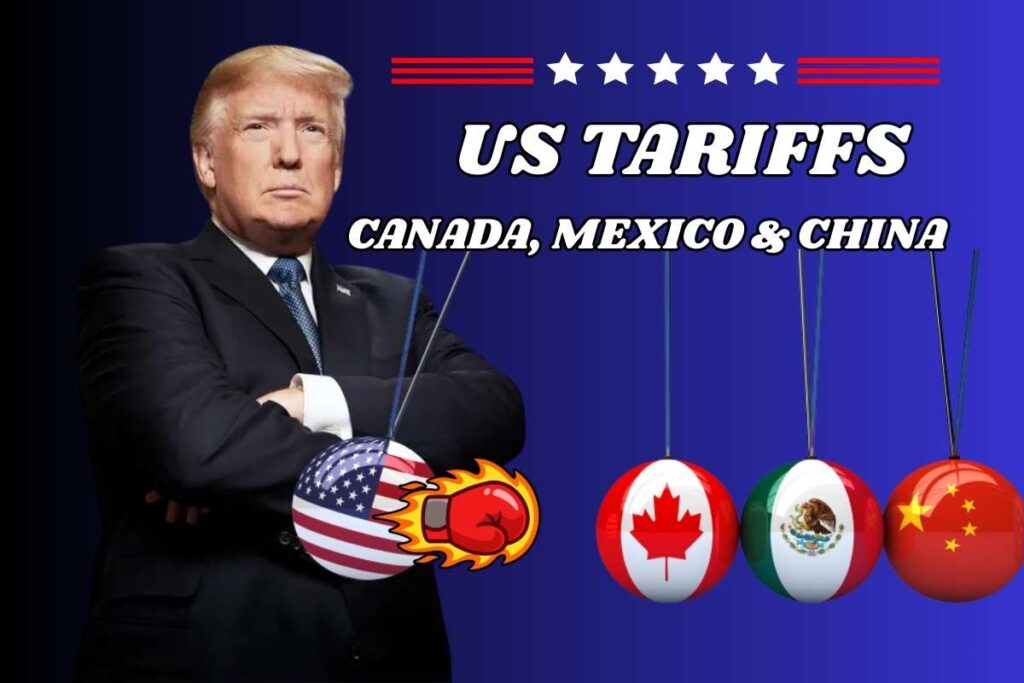In early 2025, then-President Donald Trump, now in his second term, imposed massive US Tariffs on Canada, Mexico & China. The tariffs are 20% to 25% across a wide range of industries, including cars, medical equipment, and household goods. While the administration insists the actions will shield domestic industries and lower trade deficits, critics contend they have the potential to inflate prices, damage foreign relations, and cause economic uncertainty.
US Tariffs on Canada, Mexico & China
The Canada, Mexico, and China tariffs are a sudden reversal of U.S. trade policy, with long-term repercussions. Although the aim is to safeguard American industries and workers, the short-term effect is higher costs, economic uncertainty, and tense diplomatic ties. Goods such as autos, electronics, and health care are costlier. People have to pay more for essentials after US Tariffs on Canada, Mexico & China. Trading partners have retaliated, increasing trade tensions. Companies are exploring alternative supply chain strategies.
This thorough analysis gives an accurate picture of how these tariffs affect the economy, consumers, and businesses. Following negotiations and government statements in real time will be key to grasping future trade developments.
USA Imposes Tariffs On Canada, Mexico & China
Negotiations with Mexico and Canada: May result in trade realignments or tariffs reversals. Trade war with China: May intensify if the two countries continue retaliating. Economic impact: May affect job creation, inflation, and general market stability. As the world economy responds, businesses, policymakers, and consumers have to get ready for the long-term effects of these tariffs. The situation continues to change day by day, and more policy adjustments will occur in the next several months.

Trump Imposes Tariffs On Imports – Overview
The fresh tariffs are levied on three of the United States’ largest trading partners. This is an overview of tariff rates, impacted goods, and policy rationales:
| Country | Tariff Rate | Effective Date | Products Affected | Policy Justification |
| Canada | 25% | March 4,2025 | General Goods, some energy products like Electricity , Natural Gas and oil | Addressing unfair trade practices and renegotiating energy trade deals |
| Mexico | 25% | March 4 ,2025 | General Goods, Automotive parts , steel and agricultural products | Border enforcement concerns , Illegal immigration policies |
| China | 20% | March 4,2025 | All imports including electronics , textiles, machinery and medical devices | Retaliation for Trade imbalance and national security threat |
These tariffs have direct effects on consumers and businesses as companies modify their supply chain and pricing models to pass on the added expense of imported goods.
The Logic of the Tariffs
- Balancing Trade Deficits
America has enjoyed a consistent trade deficit with these three countries, particularly China. The government’s contention is that these tariffs will balance by dissuading foreign dependence and spurring domestic production.
- Safeguarding Domestic Industries
Another central objective of such tariffs is the growth in American manufacturing. By making imports more costly, U.S. businesses would gain from less competition, which would push the development of jobs and economic growth in sectors like steel, cars, and electronics.
- Enhancing National Security
In the case of China, the tariffs are also a reaction to national security and economic espionage. The United States has accused China of intellectual property theft and unfair trade on the basis of the need for tighter trade barriers.
- Enacting Immigration Policies
The import tariffs from Mexico also have security concerns in the border. The administration of Trump has claimed that Mexico has not been doing enough to stop illegal immigration and drug trafficking. These tariffs are an economic penalty to put pressure on Mexico to enforce more strongly.
Trump Imposes Tariffs on Imports
These tariffs have serious impacts on industries, resulting in increased prices, possible lay-offs, and market reorganization.
- Automotive Industry – The 25% tax on foreign auto parts will raise the cost of production for American automakers. Ford, GM, and Tesla will be forced to increase the price of automobiles, which will raise the cost of automobiles for consumers. This will result in reduced sales and possible loss of employment in the automobile industry.
- Consumer Goods & Electronics – Most electronics and appliances are made in China, therefore laptops, mobile phones, and TVs will become more costly. Big corporations such as Apple, Dell, and HP will have to move production overseas so they don’t incur tariffs. Walmart and Target consumers will experience higher prices, and it will touch tens of millions of consumers.
- Pharmaceuticals & Medical Devices – Medical devices tariffs would jeopardize the medical system. Hospitals and clinics depend on cheap medical gear produced in Mexico and China. Increased cost might add to the medical expenses of patients.
- Agriculture & Food Industry – The United States depends on Mexico and Canada for most of its fruits, meats, and produce. Increased tariffs on imports would make groceries expensive, leading to inflation and escalating consumer prices. Farmers are also worried about being hit with Mexican retaliatory tariffs, discouraging demand for American farm products.
International Reaction & Retaliation
The trade partners have been angered by these tariffs and have set retaliatory tariffs of their own on American goods.
- Canada: Enacted tariffs on American steel, aluminum, and agriculture.
- Mexico: Levied increased taxes on U.S. corn, dairy products, and machinery.
- China: Raised tariffs on U.S. soybeans, automobiles, and semiconductors, widening the ongoing trade war.
Frequently Asked Questions US Tariffs on Canada, Mexico & China
Why did Trump introduce these tariffs?
The government argues that these tariffs are required to balance trade, defend American industries, and enhance national security.
How do tariffs affect American consumers?
American consumers can see increased prices on cars, electronics, food, and healthcare services. This can decrease purchasing power and lead to inflation.
Do firms have ways to circumvent tariffs?
Some firms will relocate production overseas to evade tariffs. Others will raise the cost of the product and add it to the price.
What are the worst-hit products after US Tariffs on Canada, Mexico & China?
Some of the worst-hit products are:
Cars and automotive components
Electronics and mobile phones
Medical equipment and drugs
Foodstuffs (fruits and vegetables, milk and dairy, meat)
How long will the US tariffs remain in effect?
Their length will be determined by future trade talks and political factors. Tariffs will stay in place until “fair trade deals” are agreed, the administration assures us.
Are these tariffs a shift from past trade policy?
These tariffs are the highest in years and signal a tougher stance than past administrations.




